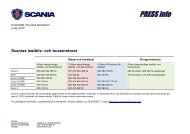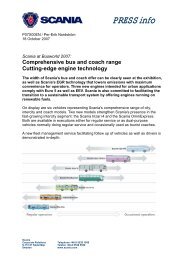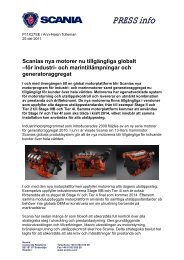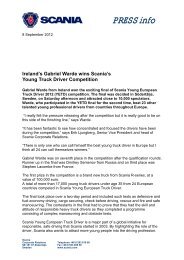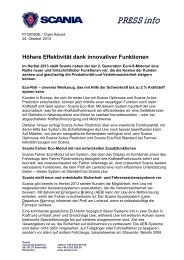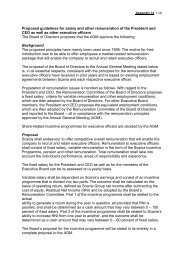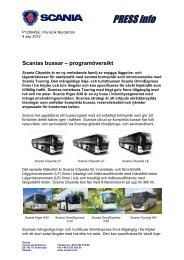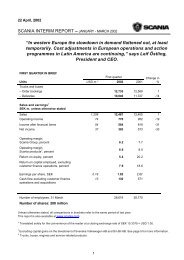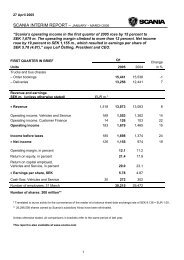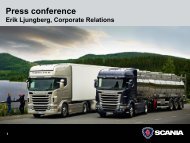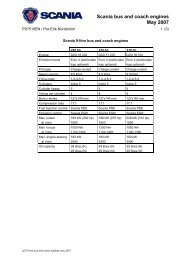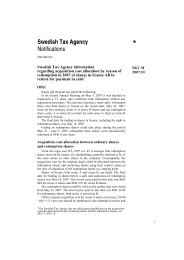Scania Annual Report 2011
Scania Annual Report 2011
Scania Annual Report 2011
You also want an ePaper? Increase the reach of your titles
YUMPU automatically turns print PDFs into web optimized ePapers that Google loves.
100 years of<br />
innovation<br />
In <strong>2011</strong>, <strong>Scania</strong>’s bus and coach operations<br />
celebrated their 100th anniversary.<br />
<strong>Scania</strong>’s bus and coach operations have<br />
always been characterised by an intrinsic<br />
innovative capability. Customised solutions<br />
fully supported in the market have always<br />
been essential in building durable relationships<br />
with bus and coach customers all<br />
over the world. This was true even 100<br />
years ago, and perhaps is even more important<br />
today considering the challenges<br />
that the entire transport industry is facing<br />
when it comes to developing efficient and<br />
sustainable transport solutions.<br />
During the 1930s, buses dominated<br />
<strong>Scania</strong>-Vabis sales. After the Second<br />
World War, <strong>Scania</strong>-Vabis aimed to establish<br />
the make in markets outside Sweden’s<br />
borders. The Nordic countries were close<br />
at hand, but sales also began in continental<br />
Europe and in Brazil.<br />
Later technological milestones were<br />
the Metropol and Capitol buses from the<br />
early 1950s, based on a bus concept from<br />
U.S.-based Mack. The buses departed<br />
from European tradition by virtue of their<br />
U.S. design and rear-mounted engines.<br />
MARKET – BUSES AND COACHES<br />
The <strong>Scania</strong>-Vabis “Bulldog” was a pioneer because of its simple design, which minimised size and weight.<br />
This bus was delivered to a local bus company in Mölnlycke, Sweden in July 1932.<br />
”The silent bus”, launched in 1971, featured<br />
a radical approach for reducing the<br />
outside noise level to 77 dBA, which even<br />
40 years later lies within the standards<br />
required by legislation.<br />
In the early 1980s, <strong>Scania</strong> implemented<br />
a far-reaching modularisation. More and<br />
more components could be utilised in both<br />
buses and trucks.<br />
<strong>Scania</strong>’s ethanol buses were developed<br />
in the second half of the 1980s in<br />
collaboration with the Greater Stockholm<br />
Public Transport Company Limited (Storstockholms<br />
Lokaltrafik), which gradually<br />
expanded its ethanol bus fleet. Meanwhile<br />
the buses were also sold to other countries,<br />
including Brazil.<br />
Over a 20-year period, <strong>Scania</strong> has tested<br />
a number of hybrid concepts. The latest<br />
of these, featuring an ethanol engine, also<br />
went into commercial service in Greater<br />
Stockholm. One of the hybrid buses was a<br />
visionary concept that demonstrated how<br />
transport operators can further boost the<br />
attractiveness of taking the bus, compared<br />
to driving and being stuck in traffic jams.<br />
During the 21st century, there is increased<br />
demand for larger, more efficient<br />
bus systems, particularly in major cities<br />
where congestion and pollution pose a<br />
significant challenge. In recent years,<br />
<strong>Scania</strong> has delivered buses and services<br />
for such systems, including in South<br />
Africa.<br />
25<br />
The so-called “Nordmark” bus was the<br />
first entirely Swedish-built omnibus. Built<br />
by <strong>Scania</strong> in Malmö in 1911 on a truck<br />
chassis, it was fitted with an engine and<br />
body at Vabis in Södertälje, Sweden.<br />
Motor vehicles found it difficult to cope<br />
with wintry road conditions. <strong>Scania</strong>-Vabis<br />
constructed fifteen motorised mail buses in<br />
collaboration with the Swedish Post Office<br />
(1922-23). The first models were fitted with<br />
track drives and forward-mounted snow<br />
runners, enabling them to be used when the<br />
road was completely snow-covered.<br />
The B75 was <strong>Scania</strong>’s first Brazilian bus.<br />
Starting in 1959, this bus served on<br />
long-distance routes between São Paulo<br />
and Sumeré, Brazil. Due to the length of<br />
the run, the bus covered 2,500,000 km in<br />
only 13 years.<br />
The new <strong>Scania</strong> Citywide bus series was<br />
introduced in <strong>2011</strong>. It includes city and<br />
suburban buses in numerous modularised<br />
variants. Its design has clear <strong>Scania</strong> features<br />
that are noticeable on the roads.<br />
Operations <strong>Scania</strong> <strong>2011</strong>



